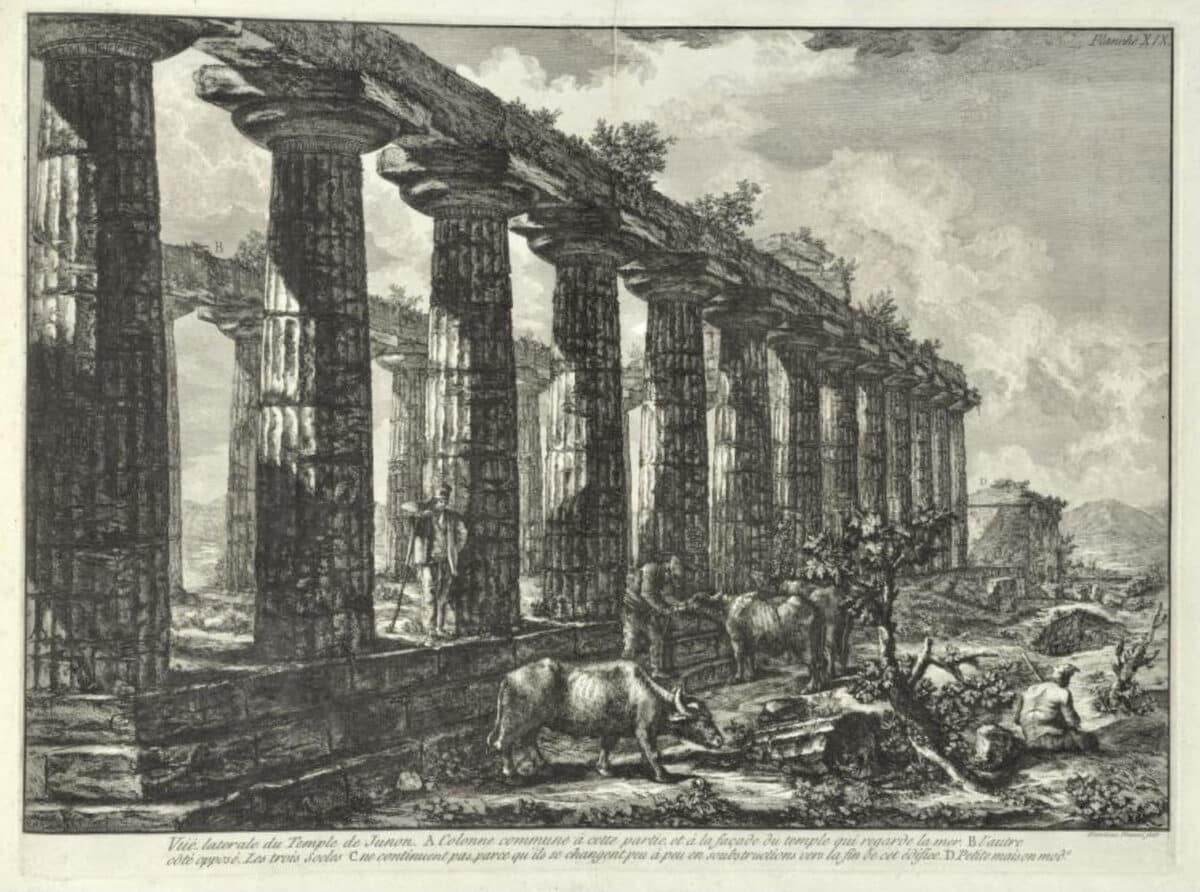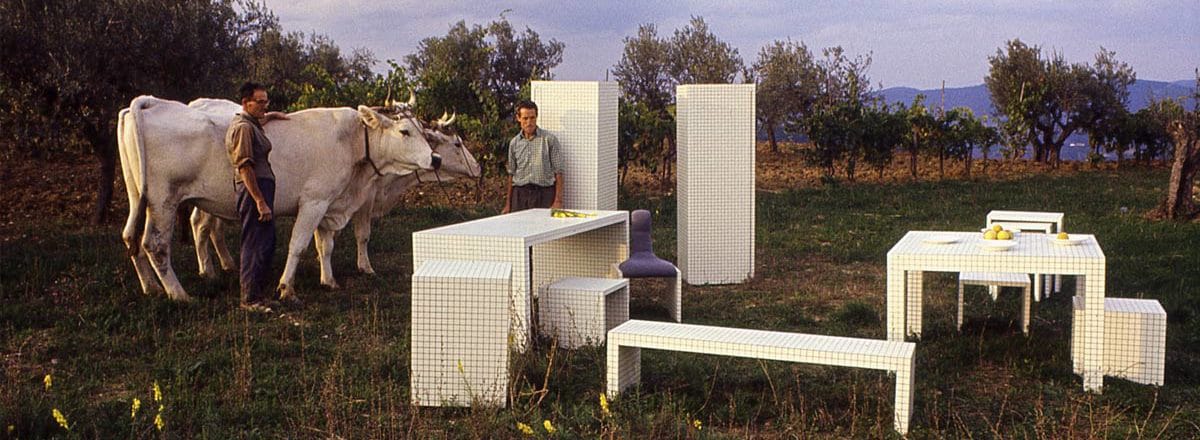Superstudio & Piranesi: Zeno is Immortal

It’s 1777 in the Italian region of Salerno, a man is resting on a massive Doric column, watching his two cows from the ruin of a temple where the weeds grow. This building was, a long time ago, considered as the house of Juno, goddess of fertility and the vital force. Today, this building is merely a support for this farmer’s everyday life. The pedestal offered by the ruin seems to be an appropriate place from which to keep an eye on the beasts. The authority and holiness of the building have faded, leaving a functional, prosaic structure. Any beliefs surrounding the building disappeared centuries ago, with the banality of everyday life settling in the place of powerful gods. All faith is gone and its illusions are lost in weeds. The colossal columns are battered by time; the goddess Juno is forgotten and the temple representations have vanished; the eyes of the farmer are closed.
The quietness of the scenery is not a common sight in a Piranesi drawing. [1] Far from the infernal ‘Carceri’, the dramatic ‘Vedute di Roma’, and his monumental projects, the Paestum drawings seem to be more serene, with the human subject represented in detail. The wild weeds growing from the ground to the top of the monument could be interpreted as the force of untrammelled nature, set up in opposition to the failure of human desire for order. Between banality and drama, the austerity of the colonnade drawing is contextualised in its casual but immanent milieu: on one hand, the perspective axis dramatizes the imposing aspect of the architecture; on the other, the ruin is represented in its bucolic and rural context. The magnitude of the architecture is, however, overrun by the aforementioned grasses that the cows are eating between the stones. Assembled a long time ago by the farmer’s ancestors, the stones have now lost their transcendental meaning bestowed by religious belief, now, all around the temple, life takes place; its immanence replacing transcendence. Now the tiny weeds are stronger than the stones. The relationship between the ruins and the landscape represented in this painting was described by Marguerite Yourcenar in her book Le Cerveau Noir de Piranèse (translated, The Dark Mind of Piranesi): ‘The destroyed temple is not only a wreck on the sea of forms; it is nature in itself: the drums of its columns are similar to precious wood; space and height are Dorian melodies; its ruin is a precept, admonition, a state of things. The work of the tragic architecture poet reached its end, finishing in a serein ecstasy’. [2]
In Piranesi’s previous etchings, the imaginary was often focused on human alienation, in which architecture was generally presented as an instrument of domination: monuments, jails, heavy historical references, exaggerated titanic ruins, etc. Here, the temple is an integral part of the landscape and the life of the inhabitants. The ruin is part of a peaceful ecosystem where architecture, human daily life and plants exist alongside one another. Following the violence of many of Piranesi’s earlier works, the quietness exhibited here brings the engraver’s life to a serene conclusion. The farmer replaces the insignificant human form lost amongst the gigantic architecture. Restlessness, torture, excessive monumentality, and fires were more common in Piranesi’s engraving than peacefulness. In ‘Carceri’ we are incarcerated, in ‘Vedute di Roma’, human life is in perpetual motion, lost between colossal monuments; here, the farmer subject lives in the immanence of a harmonious nature with his eyes closed. It is a work that questions all of his previous engravings.
While Piranesi dedicated his main career to the infernal environment of humankind, this final project presents us with an understanding of the contrast between urban alienation and rural stability. ‘Paestum’ is a testimony to Juno’s ruins that conveys the contemporary lifestyle of Piranesi. The farmer’s way of life is undoubtedly older than the temple itself, almost unchanged from the origin of sedentary organisation.
‘Remain faithful to the earth, my brothers, with the power of your virtue! Let your bestowing love and your knowledge serve the meaning of the earth! Thus I beg and beseech you.
Do not let it fly away from earthly things and beat against eternal walls with its wings! Oh, there has always been so much virtue that flew away!
Like me, guide the virtue that has flown away back to the earth – yes, back to the body and life: so that it may give the earth its meaning, a human meaning!’ [3]

Two hundred years later in the Maremma region of northern Italy, a farmer with his two cows observes some unusual furniture, all covered in the same white and nihilistic pattern. The furniture exists in stark contrast with the pastoral landscape, leading us to question the presence of the farmer and his archaic lifestyle. The objects represent what could be the ultimate stage of abstraction, while the farmer and his cows are just the same as the figures in Piranesi’s drawing. This picture relates to two projects realised by Superstudio: ‘La Coscienza di Zeno’ and ‘La Serie Misura ‘M’’.
The contrast between these two themes is comparable to Piranesi’s urban representations in ‘Paestum’: one is depicted as an urban lifestyle distanced from earth and nature, where architecture is omnipresent; the other is an extra-urban lifestyle where human life remains connected to its natural context. Here, the two organisations are confronted with the same image. While the temple covered with grass in Piranesi’s painting represents a remaining piece of the past, the farmer and the furniture represent two contemporary lifestyles: one working with nature, and the other resulting from industrial societies. Obviously, agriculture is often part of a similar productive system, but as we will see later, Zeno’s lifestyle is far from this agricultural form of earthly exploitation.
‘La Coscienza di Zeno’ was presented at the 1973 Venice Biennial as a piece of anthropological research directed by Superstudio and illustrated by Alessandro Poli. Zeno, a Tuscan farmer living close to Poli’s recently owned land, was considered a model of autonomy and stability:
‘We recognize from this agricultural lifestyle a moment preceding any alienation process caused by the rise of capitalism, where the relation of the urban individual, together with his own reality, is globally constrained to survive under the pressure of external mechanisms. On the other hand, we are interested in highlighting the primary aspect of the agricultural tools in which, every object is characterized by its use value, and where every transformation is realized within the holistic knowledge of the reality in which it operates.’ [4]
Superstudio tries to make him talk, but Zeno has nothing to say. He is at the opposite of theory, far from any experimentation or creation. His lifestyle is the result of a long oral history learned by practice throughout his entire lifetime. The resulting craftsmanship is not interested in any aesthetic or creative knowledge: necessity is the only objective. For Superstudio, his lifestyle was considered an example of total autonomy and, following on from this, is shown as a counter-example of capitalism, offering a possible way out of the current conditions.
In reality, Superstudio attempted to consider Zeno’s knowledge as a liberation and a creative therapy. But the true liberty of Zeno is in his submission to immanence. The Florentine architects, from their point of view – consciously or not – misunderstand the farmer’s lifestyle and try to make it fit into the creative process: ‘Our work at the university is to analyse the act of projecting (its motivation, its modes of operation, its social and environmental relations), by researching an alternative mode.’ [5] Because of their interest in alternatives, the project collapses. As proposed in this essay, Zeno’s lifestyle has not changed in hundreds or even thousands of years. Like the farmer spotted among the ruins of Juno’s temple, would Zeno’s lifestyle survive the collapse of our current beliefs and continue amidst their ruins?
From the ‘Paestum’ to the Maremma farmer, the same knowledge transmitted by oral traditions seems to have evolved through posterity; representing a certain ideal of stability, their lifestyle is opposed to eternal disequilibrium. Piranesi and Superstudio dedicated their careers to studying their contemporary urban systems, represented by gargantuan cities in which architecture is omnipresent, surrounding each human individual in a built-up environment. However, from an interpretation of ‘Paestum’ and the Superstudio studies on Zeno, we can see an interest in rural life – its autonomy, quietness and stability. These two images represent a profound displacement in their careers. Their rural representations increase the intensity of their urban projects, by creating contrast and by showing another possible world. In response to an alienating society, some ambiguous beliefs emerge by attempting to intellectualize the ordinary nature of craftsmanship, ascetic primitivism, and the simplicity of nature – however, by denaturing them at the same time. Indeed, researching transcendental ideals in immanent reality is likely to fail but will always remain as a source of inspiration.
Olivier Bellflamme is the founder of Lucrèce Project and is currently working on an Architectural Design PhD at the Bartlett, together with indigenous communities from the Western Sierra Madre, Mexico.
This text was entered into the 2020 Drawing Matter Writing Prize. Click here to read the winning texts and more writing that was particularly enjoyed by the prize judges.
Notes
- This painting was in reality realised by the son of Giovanni Battista Piranesi, Francesco Piranesi, on the basis of his father’s sketch. Indeed, the Paestum trip of the famous engraver was the last journey before dying. One year after, in 1778, Francesco finished and published these views as parts of a collection of view: the Différentes Vues de Pesto.
- Marguerite Yourcenar, Le cerveau noir de Piranèse. Les prisons imaginaires. 16 gravures de Piranèse, (Tesserete: Moto&Images, 2016) p.33. Translated from French.
- Friedrich Nietzsche, Nietzsche: Thus Spoke Zarathustra, (Cambridge ; New York: Cambridge University Press, 2011) p.55.
- Superstudio, Works 1966-1978, (Macerata: Quodlibet, 2017) p.536. Translated from Italian.
- Superstudio, Works 1966-1978, (Macerata: Quodlibet, 2017) p.562. Translated from Italian.
